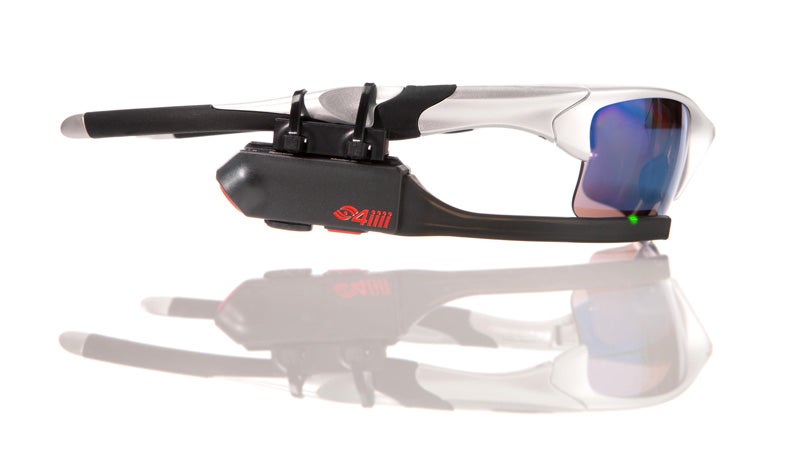Your next workout might soon be a bit more techie.╠řA new wave of gear promises to reinvent the way you work out, providing richer data, a more complete picture of your health, and more accessible stats. But will these seven wearable gadgets motivate you to get up in the morning and head out on a run? Stranger things have been known to happen.╠ř
╠ř
Basis Carbon Steel ($199)
Basis╠ř╠řfor 2014. The stylish silver-and-black watch looks like something you could wear to work, but it has an optical blood flow sensor under the band to detect your pulse count. As you work out, you can quickly glance down to see the rate. A ÔÇťhabitÔÇŁ system helps you track accomplishments on your phone or computer.
Multiple position sensors can also monitor how you sleepÔÇötracking tosses and turns, deep sleep, and interruptions at night. The result is one of the best fitness watches around because it is╠řalways╠řmonitoring, not just when you have a heart rate sensor strapped to your chest.
Push Band ($150)╠ř
Few fitness trackers can monitor a weight-lifting program this thoroughly. Available this spring, the╠ř╠řstraps around your arm and detects microscopic movements, feeding the data to a free smartphone app. You can set up a workout session in the appÔÇöchoose the number of reps or the total workout timeÔÇöthen use the band for performance data.
You can track actual reps, the force of the lift, your balance and tempo, and even those times when you showed explosive strength. Once youÔÇÖre done, you can share the results with friends. The added bonus? You can skip the workout session and just use the band for monitoring results.
Adidas MiCoach X_Cell and Textile Strap ($70)
One of the big changes with smartphones over the past few months has to do with Bluetooth Low Energy (BLE), which is marketed as the power-efficient╠ř. For those just wanting to do a workout, itÔÇÖs a much faster processÔÇögadgets like the╠ř╠řmeasure your heart rate, but they now connect over BLE directly to a smartphone like the Nokia╠řLumia╠ř1020. ThereÔÇÖs no need for an extra adapter that clips to your phone.
The╠řLumia╠řapp is also much more powerful, letting you track actual workout data. The Adidas Energy Boost all-weather sneakers provide a compartment under the in-sole for the Speed_Cell sensor to track running distance, cadence, and even your best time. You can also share this data on the╠řMiCoach╠řsite.
iBike Newton+ Powerstroke ($499)
For most cyclists, the more data you have about a workout the better. It means you can adjust your riding style, route, or even pick a different bike altogether to match your goals. This (relatively) low cost╠ř╠řshows basic info like cycling strokes, but can also measure much moreÔÇöwatts, calories, elevation changes, and even wind resistance.
You can download the data you collect from a ride to a PC or Mac app, then share it with friends. The cycle monitor clips onto the handlebars of your bike and lasts about 20 hours per charge.
4iiii Sportiiiis ($149)
This╠ř╠řchanges your workout in one important wayÔÇöby providing the information you need in your field of vision. Many trackers show your heart rate or pulse, but you have to look down, which can be dangerous in a city or difficult in bright sunlight.
The╠řSportiiiis╠řconnects to your existing prescription glasses or sunglasses, and then connects over Bluetooth to a heart rate monitor you wear across your chest. As you work out, lights appear on a thin wand that sits just below your field of view. Green means you are in an aerobic mode, red means you are pushing hard, and blue means youÔÇÖre cooling down.
Reebok CheckLight ($150)
Many fitness gadgets are designed to measure low-impact sports like running or walking. The╠ř╠řis designed for more aggressive sports like boxing, hockey, and football. As you engage in the sport, the cap tracks impacts to the headÔÇögreen for contact, yellow for slight impact, and red for more severe hits.╠ř
This helps you (and coaches) make sure you haven't had too many sustained hits during a game. The cap can be worn alone or under a helmet, and comes in several sizes to accommodate kids and adults.
Garmin Forerunner 620 ($400)
Geared specifically to the avid runner, the╠ř╠řtracks all of the typical running variablesÔÇöspeed, distance, and route. (The device, not much bigger than an ordinary watch, has a built-in GPS sensor.) When used with the Garmin╠řHRM-Run╠řmonitor that straps to your chest, you can also see your heart rateÔÇöand much more.
Unlike most watches, you can track the amount of time your foot touches the pavement, the ÔÇťbounceÔÇŁ you generate, and the actual recorded cadence (not just the strike rate). Plus, the watch is easy to useÔÇöthereÔÇÖs a large Run button on the display, and the text is bold and easy to read.╠ř


